
Managing Knee Pain: Causes and Treatments | Burbank, Century City, Los Angeles CA
Knee pain is a common complaint that affects people of all ages and lifestyles. Whether it’s a dull ache after a long day or sharp discomfort with every step, knee pain can significantly impact your quality of life and mobility. In this blog, we’ll explore the various causes of knee pain and discuss effective treatments to help you find relief and regain function.
Causes of Knee Pain:
- Osteoarthritis: One of the leading causes of knee pain, osteoarthritis is a degenerative joint disease characterized by the breakdown of cartilage in the knee joint. This can lead to inflammation, swelling, stiffness, and pain, especially with movement.
- Injuries: Traumatic injuries such as ligament tears (e.g., ACL tear), meniscus tears, or fractures can cause acute knee pain. Sports-related injuries, falls, and accidents are common causes of knee injuries.
- Overuse and Strain: Activities that place repetitive stress on the knee joint, such as running, jumping, or squatting, can lead to overuse injuries like patellar tendinitis or iliotibial band syndrome, resulting in pain and inflammation.
Treatments for Knee Pain:
- Rest and Ice: For acute injuries or flare-ups of knee pain, rest and ice therapy can help reduce inflammation and provide temporary relief. Resting the knee and applying ice packs for 15-20 minutes several times a day can alleviate pain and swelling.
- Physical Therapy: A tailored physical therapy program can help strengthen the muscles around the knee, improve flexibility, and correct biomechanical issues contributing to knee pain. Therapeutic exercises, stretches, and manual techniques can aid in pain management and functional improvement.
- Medications: Over-the-counter pain relievers such as acetaminophen or nonsteroidal anti-inflammatory drugs (NSAIDs) can help alleviate mild to moderate knee pain and reduce inflammation. In some cases, prescription medications or corticosteroid injections may be recommended for more severe pain.
- Bracing and Supportive Devices: Depending on the underlying cause of knee pain, wearing supportive braces, orthotics, or using assistive devices like canes or crutches may provide added stability and reduce strain on the knee joint during activities.
- Surgery: In cases where conservative treatments fail to provide relief, surgical intervention may be necessary. Procedures such as arthroscopic surgery, knee replacement, or ligament reconstruction may be recommended to address structural abnormalities or severe joint damage.
Knee pain can significantly impact your daily life and mobility, but effective treatments are available to help you manage symptoms and improve function. Don’t let knee pain hold you back – take the first step towards a pain-free, active lifestyle today.

